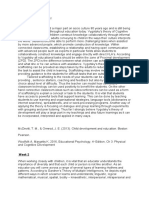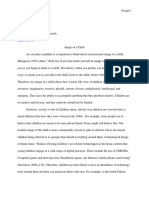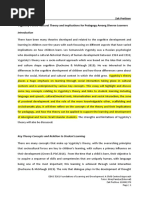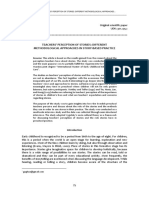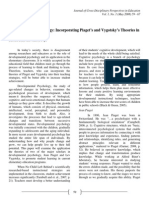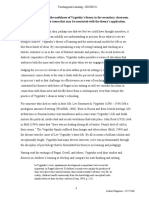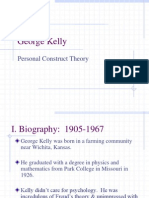DBB 220 Eaa 03 e 1548986 D
DBB 220 Eaa 03 e 1548986 D
Uploaded by
api-525729942Copyright:
Available Formats
DBB 220 Eaa 03 e 1548986 D
DBB 220 Eaa 03 e 1548986 D
Uploaded by
api-525729942Original Title
Copyright
Available Formats
Share this document
Did you find this document useful?
Is this content inappropriate?
Copyright:
Available Formats
DBB 220 Eaa 03 e 1548986 D
DBB 220 Eaa 03 e 1548986 D
Uploaded by
api-525729942Copyright:
Available Formats
Frasier Campbell Dickie ID No.
110233347
Learning and cognition assessment Vygotsky’s Socio-cultural Theory
This essay is focusing on Vygotsky’s socio-cultural theory, through out this essay there is
three main sections that will be analysed. The first section is identifying the four key
concepts in Vygotsky’s theory, the second stage looks at how Vygotsky’s concepts can be
transferred into a class room situation and the third stage is looking at the strengths and
weaknesses of the theory.Vgotsky’s theory is a sociocultural theory, which means when a
child communicates with peers or more knowledgeable people in their society, it moulds
their behaviour and thinking (Woolfolk and Margetts 2013, p. 95).
Key Concepts
Zone of proximal development is when a child is at a level of discomfort where they are
unable to solve a problem and they need assistance from a knowledgable peer or a
teacher (Woolfolk and Margetts 2013. They can give them clues, reminders or steps to
help them solve the task (Woolfolk and Margetts 2013, p 98). What this does for a child is
that the assistance from the teacher gives them a helping hand with the task, when the
child becomes competent with the task they don't need the assistance, so they are able to
do the task independently (Muirps 2014).
Socio-dramatic play is when children interact with each other and they play in a setting
where each child has a social roles (Wolfgang, Mackender, & Wolfgang 2013, 1981). As an
example one child could be a doctor and the other being a patient and the child that is the
doctor gives the patient a cup of medicine. This is important for a child that is in pre school
as they are able to develop their thinking, looking past an object of its literal meaning and
see the object abstractly(Woolfolk and Margetts 2013, p.102). Socio-dramatic play can
also develop children’s language as they would use more words when they are talking to
each other and use words that are appropriate for the social situation (Levy, Wolfgang and
Goorland 1981, p. 246,247).
Language in Vygotsky’s theory is key because it allows people to communicate with each
other. There are three types of speech private speech, inner speech and social speech.
Private speech is when child talks to themselves silently, to help them when they are
confused, calming themselves down and problem solving (Woolfolk and Margetts 2013).
Inner speech is the thought process when they are doing a task and they do this internally
(Woolfolk and Margetts 2013). Social speech is key to a child’s learning as this speech
1 Learning and cognition, Wing Au
Frasier Campbell Dickie ID No. 110233347
ables teachers to communicate with students this is influential because a child can ask
questions and a teacher can teach by using language (Woolfolk and Margetts 2013).
Vygotsky said that cultural tools are key during learning but also thinking (Woolfolk and
Margetts 2013) . There are three types of tools that a child can use when they are trying to
learn they are physical tools, symbolic tools and conceptual tools (Woolfolk and Margetts
2013, p. 96/97). Physical tools are pencils, rulers, computers and phones. Symbolic tools
are number systems, maps and language. Conceptual systems which are theories,
literature and scientific models (Woolfolk and Margetts 2013, p. 96/97).
Putting the concepts into the classroom
Transferring Vgotsky’s language is important to any classroom situation as these concepts
can help the teacher communicate with the student. If children don't understand something
about a task or what the teacher is teaching they will communicate by asking a question.
By using social speech in a class room we are able to teach children and also children can
communicate with me so they are able to understand the activity.
Teaching like Vygotsky teachers will need to be in the zone where they don't make the task
to easy but still challenges the children. If the student does not understand the task or is
finding it challenging, teachers will be there to assist the student. Another way of a child
learning through zone proximal development is putting children into a group and if one
child does not get the task there will be other students that can assist the student. This can
be better then a teacher trying to help the student because peers can understand the
child’s zone of proximal development (Woolfolk and Margetts 2013, p. 98).
Cultural tools in a classroom can help children out when they are stuck with a problem, for
example if a child is stuck with a task there are tools that can assist them with a task. A
child is having trouble with writing a narrative introduction, if the teacher has the smart
board on with key cues saying what should be in an introduction Who?What?Where and
When ? The child reads it and helps them remember whats in the introduction. In this
example here the teacher has used the tools by having the smart board which is a physical
tool, symbolic tool is the language which is english and the conceptual system is the
literature of the key cues.
2 Learning and cognition, Wing Au
Frasier Campbell Dickie ID No. 110233347
Strengths and Weaknesses
Weaknesses to Vgotsky’s work is that since he past way so early in his life, his work is
unfinished which left some grey areas. As an example he talks about mental age but
people are uncertain on how to relate it back to an age period, which leads people trying to
make interpretations on Vygotsky’s work (Chaiklin 2003, p. 56). Vygotsky did not take into
consideration that children may learn about different processes before they are taught
them,this point is relevant in todays teaching society as children have a greater opportunity
to learn through cultural tools as they are more accessible (Woolfolk and Margetts, p. 100).
Vygotsky was able to implement and show new ways to teach children, by presenting his
theories he has shaped teaching in a way. He does not isolate his theory towards one
section of the world, as he looks and explains how children will learn different skills by their
cultural influences and how these influences develop them as a person (Woolfolk and
Margetts 2013, p. 100). Another strength is that Vgotsky’s key concepts are used today in
classrooms, by having concepts that are still used today it shows us that how important he
was in developing children’s cognitive development and problem solving.
Conclusion
Vgotsky socio-cultural theory is a theory that teachers are able to still able to use. The key
concepts are well researched and they provide a solid foundation for teachers to use to
develop cognitive development, problem solving and learning. The only negatives is that
Vgotsky passed away so early in his life time, that created the problem that he did not get
to expand on some aspects of his theory. Overall the socio-cultural theory is an important
to the educational system as it provides a knowledgable understanding on how children
learn and develop.
Reference list
Woolfolk, Anita, and Kay Margetts. Educational Psychology. 3rd ed. New South Walws: Pearson
Education, 2013. Print.
Muirps, Kerri. "Zone Of Proximal Development". (2014): n. pag. Web. 28 Mar. 2017.
Wolfgang, C.H., Mackender, B., & Wolfgang, M. (1981). Growing and learning through play.
New York: Instructo/McGraw-Hill.
Levy, Ann K, Charles H Wolfgang, and Mark A Goorland. "Sociodramatic Play As A Method For
Enhancing The Language Performance Of Kindergarten Age Students". Florida House of
Representatives 1 (1992): 246,247. Web. 28 Mar. 2017.
3 Learning and cognition, Wing Au
Frasier Campbell Dickie ID No. 110233347
Chaiklin, Seth. "The Zone Of Proximal Development In Vygotsky’S Analysis Of Learning And
Instruction". (2003): 56. Web. 4 Apr. 2017.
4 Learning and cognition, Wing Au
You might also like
- Emotional Intelligence by Travis BradberryNo ratings yetEmotional Intelligence by Travis Bradberry4 pages
- Bachelor of Pyschology in Honours: HDPS2603 English For Young ChildrenNo ratings yetBachelor of Pyschology in Honours: HDPS2603 English For Young Children17 pages
- Vygotsky's Socio-Cultural Theory: LanguageNo ratings yetVygotsky's Socio-Cultural Theory: Language3 pages
- Understanding Vygotsky's Sociocultural Perspective On Teaching and Learning100% (1)Understanding Vygotsky's Sociocultural Perspective On Teaching and Learning11 pages
- Describe and Evaluate Vygotsky's Theory of Cognitive DevelopmentNo ratings yetDescribe and Evaluate Vygotsky's Theory of Cognitive Development2 pages
- supporting_teachers_in_supporting_learnersNo ratings yetsupporting_teachers_in_supporting_learners12 pages
- The Role of Language in Childrens Cognitive Development Education EssayNo ratings yetThe Role of Language in Childrens Cognitive Development Education Essay9 pages
- Zone of Proximal Development (ZPD) .: THEORY - HTMLNo ratings yetZone of Proximal Development (ZPD) .: THEORY - HTML8 pages
- Assessment 1 - ESSAY Zak Pretlove Vygotsky's Socio-Cultural Theory and Implications For Pedagogy Among Diverse LearnersNo ratings yetAssessment 1 - ESSAY Zak Pretlove Vygotsky's Socio-Cultural Theory and Implications For Pedagogy Among Diverse Learners12 pages
- Edfd127 Critical Reflection Teaching Philosophy-Folio of ReflectionsNo ratings yetEdfd127 Critical Reflection Teaching Philosophy-Folio of Reflections12 pages
- Reflect Upon Your Practice and Identify A Visual Resource That Would Stimulate The Use of Talk-Based PedagogyNo ratings yetReflect Upon Your Practice and Identify A Visual Resource That Would Stimulate The Use of Talk-Based Pedagogy8 pages
- Social Development Theory:: Who Was Lev Vygotsky?No ratings yetSocial Development Theory:: Who Was Lev Vygotsky?4 pages
- Teachers' Perception of Stories: Different Methodological Approaches in Story-Based PracticeNo ratings yetTeachers' Perception of Stories: Different Methodological Approaches in Story-Based Practice16 pages
- The Effect of Intersubjectivity On Effective Instruction in An Informal Asymmetrical Problem-Solving Situation100% (1)The Effect of Intersubjectivity On Effective Instruction in An Informal Asymmetrical Problem-Solving Situation15 pages
- Chapter 8: Jean Piaget On Cognitive DevelopmentNo ratings yetChapter 8: Jean Piaget On Cognitive Development3 pages
- The Instructional Conversation Teaching and Learning in Social ActivityNo ratings yetThe Instructional Conversation Teaching and Learning in Social Activity10 pages
- Vygotsky's Theory of Cognitive DevelopmentNo ratings yetVygotsky's Theory of Cognitive Development5 pages
- Analyzing Creativity in Childrens Picture BooksNo ratings yetAnalyzing Creativity in Childrens Picture Books31 pages
- Early Years Pedagogy and Practice-Part 2No ratings yetEarly Years Pedagogy and Practice-Part 215 pages
- The Role and Strategy To Stimulate Language Development in Early Childhood During Covid-19No ratings yetThe Role and Strategy To Stimulate Language Development in Early Childhood During Covid-199 pages
- Vygotsky's Sociocultural Theory of Cognitive Development100% (1)Vygotsky's Sociocultural Theory of Cognitive Development1 page
- Lev Vygotsky's Theory of Cognitive Development: A Simple Guide: A Simple GuideFrom EverandLev Vygotsky's Theory of Cognitive Development: A Simple Guide: A Simple GuideNo ratings yet
- How Children Learn - Book 3: Contemporary Thinking and TheoristsFrom EverandHow Children Learn - Book 3: Contemporary Thinking and TheoristsNo ratings yet
- Introduction To Matlab & Psychtoolbox 200.127.12: Intersession 2015No ratings yetIntroduction To Matlab & Psychtoolbox 200.127.12: Intersession 20152 pages
- LIGHT and DARK Oppositional Metaphor As PDFNo ratings yetLIGHT and DARK Oppositional Metaphor As PDF29 pages
- Audiology Now (Issue 21 2005) Cameron DillonNo ratings yetAudiology Now (Issue 21 2005) Cameron Dillon9 pages
- Teacher Roles in The Learner-Centred ClassroomNo ratings yetTeacher Roles in The Learner-Centred Classroom10 pages
- The Situational Approach To Language Teaching100% (1)The Situational Approach To Language Teaching2 pages
- Module 1 - Quiz About Vocabulary Instruction - Content-Based Instruction PDFNo ratings yetModule 1 - Quiz About Vocabulary Instruction - Content-Based Instruction PDF6 pages
- Impact of Online Gaming On The Academic Performance of College Students of Capiz State University Dayao Satellite College100% (1)Impact of Online Gaming On The Academic Performance of College Students of Capiz State University Dayao Satellite College5 pages
- The Relationship Between Artificial Intelligence and Psychological Theories100% (1)The Relationship Between Artificial Intelligence and Psychological Theories5 pages
- Promoting General Metacognitive Awareness: Instructional Science 26: 113-125, 1998No ratings yetPromoting General Metacognitive Awareness: Instructional Science 26: 113-125, 199813 pages
- Week 8 Remedial & Enrichment Activities - SSNo ratings yetWeek 8 Remedial & Enrichment Activities - SS18 pages
- Bachelor of Pyschology in Honours: HDPS2603 English For Young ChildrenBachelor of Pyschology in Honours: HDPS2603 English For Young Children
- Understanding Vygotsky's Sociocultural Perspective On Teaching and LearningUnderstanding Vygotsky's Sociocultural Perspective On Teaching and Learning
- Describe and Evaluate Vygotsky's Theory of Cognitive DevelopmentDescribe and Evaluate Vygotsky's Theory of Cognitive Development
- The Role of Language in Childrens Cognitive Development Education EssayThe Role of Language in Childrens Cognitive Development Education Essay
- Zone of Proximal Development (ZPD) .: THEORY - HTMLZone of Proximal Development (ZPD) .: THEORY - HTML
- Assessment 1 - ESSAY Zak Pretlove Vygotsky's Socio-Cultural Theory and Implications For Pedagogy Among Diverse LearnersAssessment 1 - ESSAY Zak Pretlove Vygotsky's Socio-Cultural Theory and Implications For Pedagogy Among Diverse Learners
- Edfd127 Critical Reflection Teaching Philosophy-Folio of ReflectionsEdfd127 Critical Reflection Teaching Philosophy-Folio of Reflections
- Reflect Upon Your Practice and Identify A Visual Resource That Would Stimulate The Use of Talk-Based PedagogyReflect Upon Your Practice and Identify A Visual Resource That Would Stimulate The Use of Talk-Based Pedagogy
- Teachers' Perception of Stories: Different Methodological Approaches in Story-Based PracticeTeachers' Perception of Stories: Different Methodological Approaches in Story-Based Practice
- The Effect of Intersubjectivity On Effective Instruction in An Informal Asymmetrical Problem-Solving SituationThe Effect of Intersubjectivity On Effective Instruction in An Informal Asymmetrical Problem-Solving Situation
- The Instructional Conversation Teaching and Learning in Social ActivityThe Instructional Conversation Teaching and Learning in Social Activity
- The Role and Strategy To Stimulate Language Development in Early Childhood During Covid-19The Role and Strategy To Stimulate Language Development in Early Childhood During Covid-19
- Vygotsky's Sociocultural Theory of Cognitive DevelopmentVygotsky's Sociocultural Theory of Cognitive Development
- Lev Vygotsky's Theory of Cognitive Development: A Simple Guide: A Simple GuideFrom EverandLev Vygotsky's Theory of Cognitive Development: A Simple Guide: A Simple Guide
- How Children Learn - Book 3: Contemporary Thinking and TheoristsFrom EverandHow Children Learn - Book 3: Contemporary Thinking and Theorists
- Introduction To Matlab & Psychtoolbox 200.127.12: Intersession 2015Introduction To Matlab & Psychtoolbox 200.127.12: Intersession 2015
- Module 1 - Quiz About Vocabulary Instruction - Content-Based Instruction PDFModule 1 - Quiz About Vocabulary Instruction - Content-Based Instruction PDF
- Impact of Online Gaming On The Academic Performance of College Students of Capiz State University Dayao Satellite CollegeImpact of Online Gaming On The Academic Performance of College Students of Capiz State University Dayao Satellite College
- The Relationship Between Artificial Intelligence and Psychological TheoriesThe Relationship Between Artificial Intelligence and Psychological Theories
- Promoting General Metacognitive Awareness: Instructional Science 26: 113-125, 1998Promoting General Metacognitive Awareness: Instructional Science 26: 113-125, 1998

















